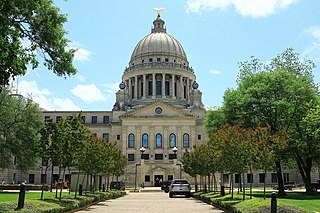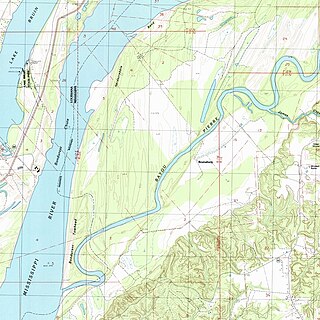
Jackson is the capital of and the most populous city in the U.S. state of Mississippi. Along with Raymond, Jackson is one of two county seats for Hinds County. The city had a population of 153,701 at the 2020 census, a significant decline from 173,514, or 11.42%, since the 2010 census, representing the largest decline in population during the decade of any major U.S. city. Jackson is the anchor for the Jackson metropolitan statistical area, the largest metropolitan area located entirely in the state and the tenth-largest urban area in the Deep South. With a 2020 population of nearly 600,000, metropolitan Jackson is home to over one-fifth of Mississippi's population. The city sits on the Pearl River and is located in the greater Jackson Prairie region of Mississippi. Jackson is the only city in Mississippi with a population exceeding 100,000 people.

The Natchez Trace, also known as the Old Natchez Trace, is a historic forest trail within the United States which extends roughly 440 miles (710 km) from Nashville, Tennessee, to Natchez, Mississippi, linking the Cumberland, Tennessee, and Mississippi rivers.

The Natchez Trace Parkway is a limited-access national parkway in the Southeastern United States that commemorates the historic Natchez Trace and preserves sections of that original trail. Its central feature is a two-lane road that extends 444 miles (715 km) from Natchez, Mississippi, to Nashville, Tennessee. Access to the parkway is limited, with more than 50 access points in Mississippi, Alabama, and Tennessee. The southern end of the route is in Natchez at its intersection with Liberty Road, and the northern end is northeast of Fairview, Tennessee, in the suburban community of Pasquo, at an intersection with Tennessee State Route 100. In addition to Natchez and Nashville, larger cities along the route include Jackson and Tupelo, Mississippi, and Florence, Alabama.

The Diocese of Jackson is a Latin Church diocese in Mississippi in the United States. Its ecclesiastical jurisdiction includes the northern and central parts of the state, an area of 97,458 square kilometers (37,629 sq mi). It is the largest diocese, by area, east of the Mississippi River.

Rodney is a ghost town in Jefferson County, Mississippi, United States. Most of the buildings are gone, and the remaining structures are in various states of disrepair. The town floods regularly, and buildings have extensive flood damage. The Rodney History And Preservation Society is restoring Rodney Presbyterian Church. Damage to the church's facade from the American Civil War has been maintained as part of the historical preservation, including a replica cannonball embedded above the balcony windows. The Rodney Center Historic District is on the National Register of Historic Places.

Rocky Springs is a ghost town and historic site located in Claiborne County, Mississippi, United States, between Old Port Gibson Road and the Natchez Trace Parkway. The old town site can be viewed by the public during daylight hours. Rocky Springs and the surrounding area is maintained by the National Park Service.

Coon Box, also Coonbox and Raccoon Box, is a placename in Jefferson County, Mississippi, United States. Coon Box is 5.9 miles (9.5 km) north of Fayette. The Coon Box Fork Bridge, which is listed on the National Register of Historic Places, is located one mile southwest of Coon Box.

Selsertown is an ghost town in Adams County, Mississippi, United States.

Bruinsburg is an extinct settlement in Claiborne County, Mississippi, United States. Founded when the Natchez District was part of West Florida, the settlement was one of the end points of the Natchez Trace land route from Nashville to the lower Mississippi River valley.
Uniontown is a ghost town in Jefferson County, Mississippi, United States.
Clarksville is a ghost town in Wilkinson County, Mississippi, United States.
Wharlest Jackson was an American civil rights activist who was murdered by a car bomb, with evidence of involvement by a white supremacy organization; it has been an unsolved murder since the 1960s. Jackson served as treasurer of the Natchez, Mississippi branch of the NAACP until his assassination by a car bomb, which was placed on the frame of his truck under the driver-side seat. The bomb exploded at approximate 8 p.m. on February 27, 1967. The explosion occurred when he switched on his turn signal on his way home. The explosion caused serious damage to Wharlest's lower torso and he died at the scene. The scene of his death was six blocks away from the site where he was employed, at Armstrong Rubber and Tire Company.
Danville is a ghost town in Alcorn County, Mississippi, United States.

Jones Stewart Hamilton was an American sheriff, state senator, businessman and Confederate veteran who became a millionaire through investments in railroads run by convicts he leased after the war. His mansion is the namesake of Belhaven University.

Old Greenville is a ghost town in Jefferson County, Mississippi, United States. The town was located along the old Natchez Trace and was once the largest town along the Trace. Nothing exists at the site today except the town's cemetery.

The Natchez, Mississippi slave market was a slave market in Natchez, Mississippi in the United States. Slaves were originally sold throughout the area, including along the Natchez Trace that connected the settlement with Nashville, along the Mississippi River at Natchez-Under-the-Hill, and throughout town. From 1833 to 1863, the Forks of the Road slave market was located about a mile from downtown Natchez at the intersection of Liberty Road and Washington Road, which has since been renamed to D'Evereux Drive in one direction and St. Catherine Street in the other. The market differed from many other slave sellers of the day by offering individuals on a first-come first-serve basis rather than selling them at auction, either singly or in lots. At one time the Forks of the Road was the second-largest slave market in the United States, trailing only New Orleans.
Natchez Trace is a 1960 American film starring Zachary Scott, Marcia Henderson, and William Campbell, produced by Lloyd Royal and Tom Garraway, and directed by Alan Crosland Jr. The now-lost film was based on a novel of the same name by William Bradford Huie.

William Marion Smith is a former Mississippi politician who served as a Democrat in the Mississippi Senate between 1960–1972. From 1971 to 1972, Smith was the President pro Tempore of the Mississippi State Senate. He also served at one point as interim Governor.

Brumfield High School, formerly G. W.Brumfield School, was a segregated public high school for African American students built in 1925 and closed in 1990; located in Natchez, Mississippi.

Petit Gulf was a location on the Mississippi River in North America. The gulf was an eddy or whirlpool that was smaller than the nearby Grand Gulf. The eddy lent its name to the nearby Petit Gulf Hills and Petit Gulf Creek. There was a settlement there prior to the 1828 organization of Rodney, Mississippi, and the Petit Gulf cotton cultivar, which was widely planted in the U.S. South before the American Civil War, was named for the landing and town.

















